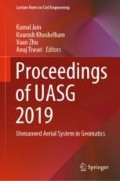Abstract
Leaf Area Index (LAI) is an important parameter in the measuring of crop health. Temporal changes in the LAI provide important information about changes in the structure of the canopy and biomass over time. In this study, RGB images of the top of the canopy are collected by using a drone and through image processing; the coverage of green canopy is calculated from the images. Subsequently, by using the gap fraction, the LAI is estimated through the Beer-Lambert law. The data is collected from Warud taluka of Amravati district of Maharashtra, India. The area is severely under biotic and abiotic stresses. A multi-rotor quadcopter, which can carry a camera, is used to fly over the citrus farm on a predefined path. A camera that is mounted on the drone takes RGB images of the top of the canopy at a continuous interval with 70% frontal and 50% side overlap. These images are stitched together and an orthomosaic image layer is formed. Mathematical models are used to find the LAI from the images. Ground truth data is collected by a ceptometer within two hours of the flight of the drone. The two LAI datasets (LAI from the digital image and the LAI values from the LAI meter) are correlated, with R2 equal to 0.73.
Access this chapter
Tax calculation will be finalised at checkout
Purchases are for personal use only
References
Qu Y, Meng J, Wan H, Li Y (2016) Preliminary study on integrated wireless smart terminals for leaf area index measurement. Comput Electron Agric 129:56–65
Chen JM, Black TA (1992) Defining leaf area index for non-flat leaves. Plant Cell Environ 15(4):421–429
Chen JM, Cihlar J (1996) Retrieving leaf area index of boreal conifer forests using landsat TM images. Remote Sens Environ 55(2):153–162
Jonckheere I, Fleck S, Nackaerts K, Muys B, Coppin P, Weiss M (2004) Methods for leaf area index determination part I: theories, techniques and instruments. Area 121: 1–42
Bonan GB (1993) Importance of leaf area index and forest type when estimating photosynthesis in boreal forests. Remote Sens Environ 43(3):303–314
Running SW, Coughlan JC (1988) A general model of forest ecosystem processes for regional applications I. Hydrologic balance, canopy gas exchange and primary production processes. Ecol Model 42(2):125–154
Fang H, Li W, Wei S, Jiang C (2014) Seasonal variation of leaf area index (LAI) over paddy rice fields in NE China: Intercomparison of destructive sampling, LAI-2200, digital hemispherical photography (DHP), and AccuPAR methods. Agric For Meteorol 198:126–141
Stroppiana D, Boschetti M, Confalonieri R, Bocchi S, Brivio PA (2006) Evaluation of LAI-2000 for leaf area index monitoring in paddy rice. Field Crop Res 99(2–3):167–170
Liu J, Pattey E (2010) Retrieval of leaf area index from top-of-canopy digital photography over agricultural crops. Agric For Meteorol 150(11):1485–1490
GSDA. Available online: http://www.webcitation.org/70mdA0g4B Accessed on 9th July 2018
Pix4D-Before starting a project. Available online: http://www.webcitation.org/71olV0COP Accessed on 9th July 2018
Carlson TN, Ripley D (1997) On the relationship between NDVI, fractional vegetation cover, and leaf area index. Remote Sens Environ. 62: 241–252
Nilson T (1971) A theoretical analysis of the frequency of gaps in plant stands. Agric. Meteorol. 8, no. C: 25–38
Liu J, Pattey E, Admiral S (2013) Assessment of in situ crop LAI measurement using unidirectional view digital photography. Agric For Meteorol 169:25–34
Graham EA, Yuen EM, Robertson GF, Kaiser WJ, Hamilton MP, Rundel PW (2009) Budburst and leaf area expansion measured with a novel mo-bile camera system and simple color thresholding. Environ Exp Bot 65(2–3):238–244
Richardson D, Jenkins JP, Braswell BH, Hollinger DY, Ollinger SV, Smith ML (2007) Use of digital webcam images to track spring green-up in a deciduous broadleaf forest. Oecologia 152(2):323–334
Kittler J, Illingworth J (1985) On threshold selection using clustering crite-ria. Syst Man Cybern IEEE Trans 5:652–655
Goudriaan J (1988) The bare bones of leaf angle distribution in radiation models for canopy photosynthesis and energy exchange. Agric For Meteorol. 38:155–255
Baret F, de Solan B, Lopez-Lozano R, Ma K, Weiss M (2010) GAI estimates of row crops from downward looking digital photos taken perpendicular to rows at 57.5° zenith angle: theoretical considerations based on 3D architecture models and application to wheat crops. Agric For Meteorol 150(11):1393–1401
Acknowledgements
The authors would like to acknowledge Ms Mrunalini R. Badnakhe for her help in acquiring the necessary permissions to fly the drone. The help of Drona Aviation Company has also been critical in the collection of drone images.
Conflicts of Interest
The authors declare no conflict of interest. The funders had no role in the design of the study; in the collection, analyses, or interpretation of data; and in the decision to publish the results.
Funding
This research was funded by Information Technology Research Academy (ITRA), division of Department of Electronics and Information Technology (DeitY), Ministry of Communications and Information Technology (MCIT), Government of India.
Author information
Authors and Affiliations
Corresponding author
Editor information
Editors and Affiliations
Rights and permissions
Copyright information
© 2020 Springer Nature Switzerland AG
About this paper
Cite this paper
Raj, R., Suradhaniwar, S., Nandan, R., Jagarlapudi, A., Walker, J. (2020). Drone-Based Sensing for Leaf Area Index Estimation of Citrus Canopy. In: Jain, K., Khoshelham, K., Zhu, X., Tiwari, A. (eds) Proceedings of UASG 2019. UASG 2019. Lecture Notes in Civil Engineering, vol 51. Springer, Cham. https://doi.org/10.1007/978-3-030-37393-1_9
Download citation
DOI: https://doi.org/10.1007/978-3-030-37393-1_9
Published:
Publisher Name: Springer, Cham
Print ISBN: 978-3-030-37392-4
Online ISBN: 978-3-030-37393-1
eBook Packages: EngineeringEngineering (R0)

